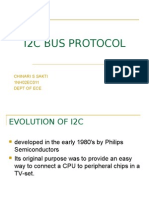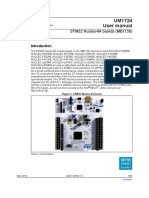Difference Between C and Embedded C
Uploaded by
Priyanka SinghDifference Between C and Embedded C
Uploaded by
Priyanka SinghC is a widely used general purpose high level programming language mainly intended for system programming.
Embedded C is an extension to C programming language that provides support for developing efficient programs for embedded devices. Embedded C is not a part of the C language. C is usually for desktop programming, while Embedded C is more suitable for embedded programming. Unlike C, Embedded C allows programmers to directly talk to the target processor and therefore provides improved performance compared to C. C creates OS dependent executable files, while Embedded C cerates files that are typically downloaded directly in to microcontrollers. Unlike C, Embedded C has fixed point types, multiple memory areas and I/O register mapping. Read more: http://www.differencebetween.com/difference-between-c-and-vs-embeddedc/#ixzz2J5LBFMUg
Looking around, we find ourselves to be surrounded by various types of embedded systems. Be it a digital camera or a mobile phone or a washing machine, all of them has some kind of processor functioning inside it. Associated with each processor is the embedded software. If hardware forms the body of an embedded system, embedded processor acts as the brain, and embedded software forms its soul. It is the embedded software which primarily governs the functioning of embedded systems.
During infancy years of microprocessor based systems, programs were developed using assemblers and fused into the EPROMs. There used to be no mechanism to find what the program was doing. LEDs, switches, etc. were used to check correct execution of the program. Some very fortunate developers had In-circuit Simulators (ICEs), but they were too costly and were not quite reliable as well.
As time progressed, use of microprocessor-specific assembly-only as the programming language reduced and embedded systems moved onto C as theembedded programming language of choice. C is the most widely used programming language for embedded processors/controllers. Assembly is also used but mainly to implement those portions of the code where very high timing accuracy, code size efficiency, etc. are prime requirements.
Initially C was developed by Kernighan and Ritchie to fit into the space of 8K and to write (portable) operating systems. Originally it was implemented on UNIX operating systems. As it was intended for operating systems development, it can manipulate memory addresses. Also, it allowed programmers to write very compact codes. This has given it the reputation as the language of choice for hackers too.
As assembly language programs are specific to a processor, assembly language didnt offer portability across systems. To overcome this disadvantage, several high level languages, including C, came up. Some other languages like PLM, Modula-2, Pascal, etc. also came but couldnt find wide acceptance. Amongst those, C got wide acceptance for not only embedded systems, but also for desktop applications. Even though C might have lost its sheen as mainstream language for general purpose applications, it still is having a strong-hold in embedded programming. Due to the wide acceptance of C in the embedded systems, various kinds of support tools like compilers & crosscompilers, ICE, etc. came up and all this facilitated development of embedded systems using C.
Subsequent sections will discuss what is Embedded C, features of C language, similarities and difference between C and embedded C, andfeatures of embedded C programming.
EMBEDDED SYSTEMS PROGRAMMING Embedded systems programming is different from developing applications on a desktop computers. Key characteristics of an embedded system, when compared to PCs, are as follows: Embedded devices have resource constraints(limited ROM, limited RAM, limited stack space, less processing power) Components used in embedded system and PCs are different; embedded systems typically uses smaller, less power consuming components. Embedded systems are more tied to the hardware.
Two salient features of Embedded Programming are code speed and code size. Code speed is governed by the processing power, timing constraints, whereas code size is governed by available program memory and use of programming language. Goal of embedded system programming is to get maximum features in minimum space and minimum time.
Embedded systems are programmed using different type of languages: Machine Code Low level language, i.e., assembly High level language like C, C++, Java, Ada, etc. Application level language like Visual Basic, scripts, Access, etc.
Assembly language maps mnemonic words with the binary machine codes that the processor uses to code the instructions. Assembly language seems to be an obvious choice for programming embedded devices. However, use of assembly language is restricted to developing efficient codes in terms of size and speed. Also, assembly codes lead to higher software development costs and code portability is not there. Developing small codes are not much of a problem, but large programs/projects become increasingly difficult to manage in assembly language. Finding good assembly programmers has also become difficult nowadays. Hence high level languages are preferred for embedded systems programming.
Use of C in embedded systems is driven by following advantages It is small and reasonably simpler to learn, understand, program and debug.
C Compilers are available for almost all embedded devices in use today, and there is a large pool of experienced C programmers.
Unlike assembly, C has advantage of processor-independence and is not specific to any particular microprocessor/ microcontroller or any system. This makes it convenient for a user to develop programs that can run on most of the systems. As C combines functionality of assembly language and features of high level languages, C is treated as a middle-level computer language or high level assembly language It is fairly efficient It supports access to I/O and provides ease of management of large embedded projects.
Many of these advantages are offered by other languages also, but what sets C apart from others like Pascal, FORTRAN, etc. is the fact that it is a middle level language; it provides direct hardware control without sacrificing benefits of high level languages.
Compared to other high level languages, C offers more flexibility because C is relatively small, structured language; it supports low-level bit-wise data manipulation.
Compared to assembly language, C Code written is more reliable and scalable, more portable between different platforms (with some changes). Moreover, programs developed in C are much easier to understand, maintain and debug. Also, as they can be developed more quickly, codes written in C offers better productivity. C is based on the philosophy programmers know what they are doing; only the intentions are to be stated explicitly. It is easier to write good code in C & convert it to an efficient assembly code (using high quality compilers) rather than writing an efficient code in assembly itself. Benefits of assembly language programming over C are negligible when we compare the ease with which C programs are developed by programmers.
Objected oriented language, C++ is not apt for developing efficient programs in resource constrained environments like embedded devices. Virtual functions & exception handling of C++ are some specific features that are not efficient in terms of space and speed in embedded systems. Sometimes C++ is used only with very few features, very much as C.
Ada, also an object-oriented language, is different than C++. Originally designed by the U.S. DOD, it didnt gain popularity despite being accepted as an international standard twice (Ada83 and Ada95). However, Ada language has many features that would simplify embedded software development.
Java is another language used for embedded systems programming. It primarily finds usage in highend mobile phones as it offers portability across systems and is also useful for browsing applications.
Java programs require Java Virtual Machine (JVM), which consume lot of resources. Hence it is not used for smaller embedded devices.
Dynamic C and B# are some proprietary languages which are also being used in embedded applications.
Efficient embedded C programs must be kept small and efficient; they must be optimized for code speed and code size. Good understanding of processor architecture embedded C programming and debugging tools facilitate this.
DIFFERENCE BETWEEN C AND EMBEDDED C
Though C and embedded C appear different and are used in different contexts, they have more similarities than the differences. Most of the constructs are same; the difference lies in their applications.
C is used for desktop computers, while embedded C is for microcontroller based applications. Accordingly, C has the luxury to use resources of a desktop PC like memory, OS, etc. While programming on desktop systems, we need not bother about memory. However, embedded C has to use with the limited resources (RAM, ROM, I/Os) on an embedded processor. Thus, program code must fit into the available program memory. If code exceeds the limit, the system is likely to crash.
Compilers for C (ANSI C) typically generate OS dependant executables. Embedded C requires compilers to create files to be downloaded to the microcontrollers/microprocessors where it needs to run. Embedded compilers give access to all resources which is not provided in compilers for desktop computer applications.
Embedded systems often have the real-time constraints, which is usually not there with desktop computer applications.
Embedded systems often do not have a console, which is available in case of desktop applications.
So, what basically is different while programming with embedded C is the mindset; for embedded applications, we need to optimally use the resources, make the program code efficient, and satisfy real time constraints, if any. All this is done using the basic constructs, syntaxes, and function libraries of C.
PROGRAMMING
USING
EMBEDDED
Embedded C use most of the syntax and semantics of standard C, e.g., main() function, variable definition, datatype declaration, conditional statements (if, switch. case), loops (while, for), functions, arrays and strings, structures and union, bit operations, macros, etc. In addition, there are some specifics to embedded C which are mentioned below: 1. Low Level Codes Embedded programming requires access to underlying hardware, i.e., timers, memory, ports, etc. In addition, it is often needed to handle interrupts, manage job queues, etc. As C offers pointers and bit manipulation features, they are extensively used for direct hardware access.
2.
In-line Assembly Code For a particular embedded device, there may be instructions for which no equivalent C code is available. In such cases, inline assembly code, i.e., assembly code embedded within C programs is used; the syntax depends upon the compiler. An example for gcc is shown here.
int asm movl :=r(b) :r(a) :%eax ); a=10, (movl %%eax, /* /* /* clobbered output input register %1, b; %%eax; %0; */ */ */
Assembly code is written in C program itself. Above code assigns a to b. Writing inline assembly code is much easier than writing full fledged assembly code.
3.
Features like Heap, recursion Embedded devices have no or limited heap area (where dynamic memory allocation takes place). Hence, embedded programs do not use standard C functions like malloc. Structures like linked lists/trees are implemented using static allocation only. Similarly, recursion is not supported by most embedded devices because of its inefficiency in terms of space and time. Such other costly features of standard C which consume space and execution time are either not available or not recommended
4.
I/O Registers Microcontrollers typically have I/Os, ADCs, serial interfaces and other peripherals in-built into the chips. These are accessed as IO Registers, i.e., to perform any operation on these peripherals, bits in these registers are read/written. Special function registers (SFRs) are accessed as shown below: SFR portb = 0x8B; It is used to declare portB at location 0x8B. Some embedded processors have separate IO space for such registers. Since there are no such concepts in C, compilers provide special mechanisms to access them unsigned char portB @portB 0x8B; In this example, @portB <address> declares portB at location 0x8B by the variable portB. Such extensions are not a part of standard C, syntax and semantics differ in various embedded C compilers.
5.
Memory Pointers Some CPU architectures allow us to access IO registers as memory addresses. This allows treating them just like any other memory pointers.
6.
Bit Access Embedded controllers frequently need bit operations as individual bits of IO registers corresponds to the output pin of an I/O port. Standard C has quite powerful tools to do bitwise operations. However, care must be taken while using them in structures because C standard doesnt define the bitfield allocation order and C compilers may allocate bitfields either from left to right or from right to left.
7.
Use of Variable data type In C, datatypes can be simply declared, and compiler takes care of the storage allocation as well as that of code generation. But, datatypes usage should be carefully done to generate optimised code. For most 8-bit C compilers, char is 8-bits, short and int are 16-bits, long is 32-bits. Some embedded processors favour use of unsigned type. Use of long and floating variable should be avoided unless it is very necessary. Using long data types increase code size and execution time. Use of floating point variables is not advised due to intrinsic imprecise nature of floating point operations, alongside speed and code penalty.
8.
Use of Const and Volatile Volatile is quite useful for embedded programming. It means that the value can change without the program touching it. Consequently, the compiler cannot make any assumptions about its value. The optimizer must reload the variable every time it is used instead of holding a copy in a register. Const is useful where something is not going to change, for e.g., function declarations, etc.
You might also like
- Tech Guide: Analog Output: Product: ZM3xx SeriesNo ratings yetTech Guide: Analog Output: Product: ZM3xx Series4 pages
- QL200 Manual y Esquematicos Del Entrenador100% (1)QL200 Manual y Esquematicos Del Entrenador41 pages
- System Reference Manual Beagleboard - Beaglebone-Ai Wiki GitHub PDF100% (1)System Reference Manual Beagleboard - Beaglebone-Ai Wiki GitHub PDF167 pages
- Basics of Smith Charts: Alan Wolke - W2AEW ARRL NNJ Technical CoordinatorNo ratings yetBasics of Smith Charts: Alan Wolke - W2AEW ARRL NNJ Technical Coordinator25 pages
- Scope of The Standard: A DB-25 Connector As Described in The RS-232 Standard100% (3)Scope of The Standard: A DB-25 Connector As Described in The RS-232 Standard11 pages
- Ham Radio Transmission Line Transformers HandbookNo ratings yetHam Radio Transmission Line Transformers Handbook61 pages
- Getting Started With Chipkit: The Arduino Compatible Pic32 Based ModuleNo ratings yetGetting Started With Chipkit: The Arduino Compatible Pic32 Based Module54 pages
- LabVIEW ArduinoInterfacingforDataAqcuisitionandTelemetrySystemNo ratings yetLabVIEW ArduinoInterfacingforDataAqcuisitionandTelemetrySystem37 pages
- The FSL Revolution - A Users Guide: Canada's Original Radio SiteNo ratings yetThe FSL Revolution - A Users Guide: Canada's Original Radio Site5 pages
- Advanced View Pic Microcontroller Projects List - PIC Microcontroller100% (1)Advanced View Pic Microcontroller Projects List - PIC Microcontroller263 pages
- Robot Programming ROS Introduction To Navigation PDF0% (1)Robot Programming ROS Introduction To Navigation PDF16 pages
- Massachusetts Institute of Technology Department of Electrical Engineering and Computer ScienceNo ratings yetMassachusetts Institute of Technology Department of Electrical Engineering and Computer Science34 pages
- How To Make A Multi-Function Arduino Robot - SriTu HobbyNo ratings yetHow To Make A Multi-Function Arduino Robot - SriTu Hobby41 pages
- Advanced Debugging of STM32-Based DevicesNo ratings yetAdvanced Debugging of STM32-Based Devices11 pages
- Multimedia Signal Processing: Theory and Applications in Speech, Music and CommunicationsFrom EverandMultimedia Signal Processing: Theory and Applications in Speech, Music and CommunicationsNo ratings yet
- ROS For Absolute Beginners (Robot Operating System) : Lentin JosephNo ratings yetROS For Absolute Beginners (Robot Operating System) : Lentin Joseph41 pages
- Star Thermal Printer Programmer's ManualNo ratings yetStar Thermal Printer Programmer's Manual117 pages
- Example Imu Unit: Acc - Gyro - 6dof On Top of Mcu Processing Unit UsbthumbNo ratings yetExample Imu Unit: Acc - Gyro - 6dof On Top of Mcu Processing Unit Usbthumb46 pages
- Arduino Lesson 10. Making Sounds: Created by Simon MonkNo ratings yetArduino Lesson 10. Making Sounds: Created by Simon Monk10 pages
- UM1724 User Manual: STM32 Nucleo-64 Boards (MB1136)No ratings yetUM1724 User Manual: STM32 Nucleo-64 Boards (MB1136)69 pages
- Autonomous Software-Defined Radio Receivers for Deep Space ApplicationsFrom EverandAutonomous Software-Defined Radio Receivers for Deep Space ApplicationsJon HamkinsNo ratings yet
- Introduction to Sensors in IoT and Cloud Computing ApplicationsFrom EverandIntroduction to Sensors in IoT and Cloud Computing ApplicationsNo ratings yet
- Accurate Microarchitecture-Level Fault Modeling For Studying Hardware FaultsNo ratings yetAccurate Microarchitecture-Level Fault Modeling For Studying Hardware Faults12 pages
- NCM - 110 Nursing Informatics Modules PDFNo ratings yetNCM - 110 Nursing Informatics Modules PDF27 pages
- Software Design and Architecture ProjectNo ratings yetSoftware Design and Architecture Project20 pages
- Programming in C by CFS (Mkhushhal - Blogspot.in) PDFNo ratings yetProgramming in C by CFS (Mkhushhal - Blogspot.in) PDF102 pages
- Brochure Simatic-Industrial-Software enNo ratings yetBrochure Simatic-Industrial-Software en28 pages
- The Impact of Information Technology On The Audit ProcessNo ratings yetThe Impact of Information Technology On The Audit Process35 pages
- Syllabus: M. Sc. Electronics and InstrumentationNo ratings yetSyllabus: M. Sc. Electronics and Instrumentation70 pages
- Namma Kalvi 6th Science Sura Sample Guide em Term 2 218564No ratings yetNamma Kalvi 6th Science Sura Sample Guide em Term 2 21856421 pages
- TO Computers: Lesson 1: Understanding The Computer SystemNo ratings yetTO Computers: Lesson 1: Understanding The Computer System34 pages
- C Clearly - Programming With C In Linux and On Raspberry PiFrom EverandC Clearly - Programming With C In Linux and On Raspberry Pi
- System Reference Manual Beagleboard - Beaglebone-Ai Wiki GitHub PDFSystem Reference Manual Beagleboard - Beaglebone-Ai Wiki GitHub PDF
- Basics of Smith Charts: Alan Wolke - W2AEW ARRL NNJ Technical CoordinatorBasics of Smith Charts: Alan Wolke - W2AEW ARRL NNJ Technical Coordinator
- Scope of The Standard: A DB-25 Connector As Described in The RS-232 StandardScope of The Standard: A DB-25 Connector As Described in The RS-232 Standard
- Getting Started With Chipkit: The Arduino Compatible Pic32 Based ModuleGetting Started With Chipkit: The Arduino Compatible Pic32 Based Module
- LabVIEW ArduinoInterfacingforDataAqcuisitionandTelemetrySystemLabVIEW ArduinoInterfacingforDataAqcuisitionandTelemetrySystem
- The FSL Revolution - A Users Guide: Canada's Original Radio SiteThe FSL Revolution - A Users Guide: Canada's Original Radio Site
- Advanced View Pic Microcontroller Projects List - PIC MicrocontrollerAdvanced View Pic Microcontroller Projects List - PIC Microcontroller
- Robot Programming ROS Introduction To Navigation PDFRobot Programming ROS Introduction To Navigation PDF
- Massachusetts Institute of Technology Department of Electrical Engineering and Computer ScienceMassachusetts Institute of Technology Department of Electrical Engineering and Computer Science
- How To Make A Multi-Function Arduino Robot - SriTu HobbyHow To Make A Multi-Function Arduino Robot - SriTu Hobby
- Multimedia Signal Processing: Theory and Applications in Speech, Music and CommunicationsFrom EverandMultimedia Signal Processing: Theory and Applications in Speech, Music and Communications
- ROS For Absolute Beginners (Robot Operating System) : Lentin JosephROS For Absolute Beginners (Robot Operating System) : Lentin Joseph
- Example Imu Unit: Acc - Gyro - 6dof On Top of Mcu Processing Unit UsbthumbExample Imu Unit: Acc - Gyro - 6dof On Top of Mcu Processing Unit Usbthumb
- Arduino Lesson 10. Making Sounds: Created by Simon MonkArduino Lesson 10. Making Sounds: Created by Simon Monk
- UM1724 User Manual: STM32 Nucleo-64 Boards (MB1136)UM1724 User Manual: STM32 Nucleo-64 Boards (MB1136)
- Autonomous Software-Defined Radio Receivers for Deep Space ApplicationsFrom EverandAutonomous Software-Defined Radio Receivers for Deep Space Applications
- Introduction to Sensors in IoT and Cloud Computing ApplicationsFrom EverandIntroduction to Sensors in IoT and Cloud Computing Applications
- Accurate Microarchitecture-Level Fault Modeling For Studying Hardware FaultsAccurate Microarchitecture-Level Fault Modeling For Studying Hardware Faults
- Programming in C by CFS (Mkhushhal - Blogspot.in) PDFProgramming in C by CFS (Mkhushhal - Blogspot.in) PDF
- The Impact of Information Technology On The Audit ProcessThe Impact of Information Technology On The Audit Process
- Namma Kalvi 6th Science Sura Sample Guide em Term 2 218564Namma Kalvi 6th Science Sura Sample Guide em Term 2 218564
- TO Computers: Lesson 1: Understanding The Computer SystemTO Computers: Lesson 1: Understanding The Computer System

























































































